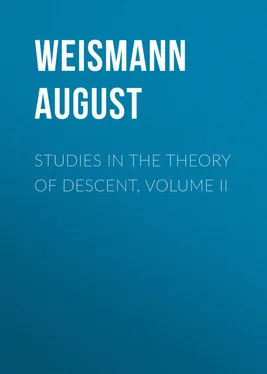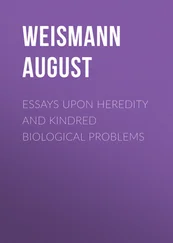August Weismann - Studies in the Theory of Descent, Volume II
Здесь есть возможность читать онлайн «August Weismann - Studies in the Theory of Descent, Volume II» — ознакомительный отрывок электронной книги совершенно бесплатно, а после прочтения отрывка купить полную версию. В некоторых случаях можно слушать аудио, скачать через торрент в формате fb2 и присутствует краткое содержание. Жанр: foreign_antique, foreign_prose, на английском языке. Описание произведения, (предисловие) а так же отзывы посетителей доступны на портале библиотеки ЛибКат.
- Название:Studies in the Theory of Descent, Volume II
- Автор:
- Жанр:
- Год:неизвестен
- ISBN:нет данных
- Рейтинг книги:4 / 5. Голосов: 1
-
Избранное:Добавить в избранное
- Отзывы:
-
Ваша оценка:
- 80
- 1
- 2
- 3
- 4
- 5
Studies in the Theory of Descent, Volume II: краткое содержание, описание и аннотация
Предлагаем к чтению аннотацию, описание, краткое содержание или предисловие (зависит от того, что написал сам автор книги «Studies in the Theory of Descent, Volume II»). Если вы не нашли необходимую информацию о книге — напишите в комментариях, мы постараемся отыскать её.
Studies in the Theory of Descent, Volume II — читать онлайн ознакомительный отрывок
Ниже представлен текст книги, разбитый по страницам. Система сохранения места последней прочитанной страницы, позволяет с удобством читать онлайн бесплатно книгу «Studies in the Theory of Descent, Volume II», без необходимости каждый раз заново искать на чём Вы остановились. Поставьте закладку, и сможете в любой момент перейти на страницу, на которой закончили чтение.
Интервал:
Закладка:
Facts of this kind indicate that Nature does not uselessly sport with forms, but that at any rate changes of this sort result from external influences. The greater frequency of variability among larvæ and its comparative rarity in imagines is also undoubtedly in favour of this view.
It has already been shown that species with variable larvæ and constant imagines are extremely common, but that those with constant larvæ and variable imagines are very rare. This confirms the conclusions, already drawn above, first, that the variability of the imago cannot owe its existence to the variability of the larvæ, and secondly, that the causes which produce variability affect the larval condition more commonly than that of the imago.
Where can these causes be otherwise sought than in the external conditions of life, which are so widely different in the two stages, and which are much more variable for the larva than for the imago?
Let us take the species of one genus, e. g. those of Deilephila . The imagines of our European species – as far as we know – all live in precisely the same manner; they all fly at twilight, 3 3 In some instances Deilephila Lineata has also been seen by day hovering over flowers.
showing a preference for the same flowers and very often frequenting the same spots, so that in the haunts of one species the others are almost always to be met with, supposing them to occur in the same locality. They conceal themselves by day in similar places, and are attacked by similar foes.
It is quite different with the caterpillars. These, even in the case of the most closely allied species, live under different conditions, as appears from the fact that they feed on different plants. The latter can, however, produce changes both directly and indirectly. The larvæ may acquire adaptive colours and markings, and these would vary in accordance with the colour and structure of the food-plant; or they may become brightly coloured as a sign of distastefulness in cases where they are inedible. Then again the colour of the soil on which the larvæ live would act upon their colours making these adaptive. Certain habits of the caterpillars may also be dependent upon the nature of their food-plants. Thus, e. g. Deilephila Hippophaës feeds only at night, and conceals itself by day under moss and among the leaves at the base of the food-plant; but D. Euphorbiæ could not acquire such a habit, because Euphorbia Cyparissias generally grows on arid soil which is poor in vegetation, and which therefore affords no concealment, and furthermore, because a caterpillar, as long as it continues to feed, cannot, and as a matter of fact does not, ever wander far from its food-plant. A habit of concealment by burying in the earth also, such for example as occurs in Acherontia Atropos , could not be acquired by D. Euphorbiæ , because its food-plant generally grows on hard, dry, and stony ground.
In addition to these considerations, the foes would be different according as the caterpillar lived on plants which formed dense thickets covering large extents of the shore ( Hippophae ) or grew isolated on dry hillocks and declivities where the herbage was scanty or altogether absent; or again, according as the insect, in conjunction with such local differences, fed by day or had acquired the habit of feeding only by night. It must in fact be admitted that new and improved adaptations, or, in more general terms, that inducements to change, when depending on the environment, must be more frequently dissimilar for larvæ than for the imagines. We must accordingly expect to find actual change, or that condition of variability which may be regarded as initiative to change, occurring more commonly in larvæ than in perfect insects.
Since facts are in complete accordance with the results of these à priori considerations we may also venture to conclude that the basis of the considerations is likewise correct, viz., the supposition that the changes of colour and marking in caterpillars, pupæ, and imagines result from external influences only.
This must not be taken as signifying that the single stages of the larval development are also only able to change through the action of external influences. The larval stages are correlated with each other, as has already been shown (see the previous essay): new characters arise in the adult caterpillar at the last stage and are then gradually transferred back to the younger stages quite independently of external influences, this recession being entirely brought about by the laws of correlation. Natural selection here only exerts a secondary action, since it can accelerate or retard this transference, according as the new characters are advantageous or disadvantageous to the younger stages.
Now as considerable individual differences appear in the first acquisition of a new character with respect to the rapidity and completeness with which the individuals acquire such a character, the same must obtain for the transference of an improvement acquired in the last stage to the next younger stage. The new character would be acquired by different individuals in different degrees and at different rates – it would have, to a certain extent, to struggle with the older characters of the stage; in brief, the younger stage would become variable.
Variability of this kind might well be designated as secondary , in contradistinction to primary variability; the latter (primary) depends upon an unequal reaction of the individual organisms to external influences, the former (secondary) results from the unequal strength and rate of the action of the innate laws of growth governing the organism. In both cases alike exceeding variability may occur, but the causes producing this variability are dissimilar.
The different stages of larval development would thus frequently display independent variability in a manner similar to the pupal or imaginal stages, since they can show individual variability while the other stages of development remain constant. This appearance of independent variability in the different stages of the larval development, however, is in truth deceptive – we have here in fact a kind of wave of variability, which passes downwards through the developmental stages, becoming gradually weaker, and finally dying out completely.
In accordance with this, we very frequently find that only the last or two last stages are variable, while the younger stages are constant. Thus in Macroglossa Stellatarum , the larvæ are constant in the first, second, and third stages, but become variable in the fourth, and in the fifth stage first show that high degree of variability which has already been described in detail (See. Pl. III Конец ознакомительного фрагмента. Текст предоставлен ООО «ЛитРес». Прочитайте эту книгу целиком, купив полную легальную версию на ЛитРес. Безопасно оплатить книгу можно банковской картой Visa, MasterCard, Maestro, со счета мобильного телефона, с платежного терминала, в салоне МТС или Связной, через PayPal, WebMoney, Яндекс.Деньги, QIWI Кошелек, бонусными картами или другим удобным Вам способом.
., Figs. 3–12). The larvæ, of Vanessa Cardui also, according to my notes, are extremely constant in the first four stages in spite of their complicated marking, but become variable in the fifth stage, although to no very great extent.
In Smerinthus Tiliæ , Ocellatus and Populi also, the greatest larval variability is shown only in the last stage, the preceding stages being very constant. These cases by no means depend upon the marking of the young stages being simpler and therefore being less capable of varying. The reverse case also occurs. In a somewhat similar manner as the young of the tapir and wild hog are striped, while the adult animals are plainly coloured, the young caterpillars of Saturnia Yamamai possess longitudinal black lines on a yellow ground, while as early as in the second stage a simple green colour appears in the place of this complicated but perfectly constant marking. If the young stages are so frequently constant, this rather depends upon the fact that the transference of a new character to these stages not only takes place gradually, but also with continually diminishing energy, in a manner somewhat similar to physical motion, which continually diminishes in speed by the action of resistance till it is completely arrested. This constancy of the younger stages may further be due to the circumstance that the characters would only be transferred when they had become fixed in the last stage, and were consequently no longer variable. The transferred characters may thus have acquired a greater regularity, i. e. a less degree of variability, than they possessed at their first origination. Extensive investigations in this special direction must be made if the precise laws, in accordance with which the backward transference of new characters takes place, are to be discovered. By such researches only should we arrive with certainty at the causes which determine the lesser variability of the young larval stages.
Читать дальшеИнтервал:
Закладка:
Похожие книги на «Studies in the Theory of Descent, Volume II»
Представляем Вашему вниманию похожие книги на «Studies in the Theory of Descent, Volume II» списком для выбора. Мы отобрали схожую по названию и смыслу литературу в надежде предоставить читателям больше вариантов отыскать новые, интересные, ещё непрочитанные произведения.
Обсуждение, отзывы о книге «Studies in the Theory of Descent, Volume II» и просто собственные мнения читателей. Оставьте ваши комментарии, напишите, что Вы думаете о произведении, его смысле или главных героях. Укажите что конкретно понравилось, а что нет, и почему Вы так считаете.












